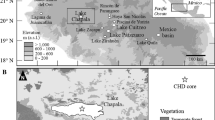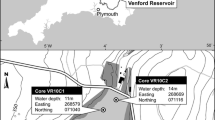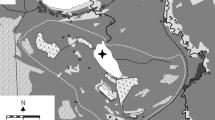Abstract
White Rock Lake reservoir in Dallas, Texas contains a 150-cm sediment record of silty clay that documents land-use changes since its construction in 1912. Pollen analysis corroborates historical evidence that between 1912 and 1950 the watershed was primarily agricultural. Land disturbance by plowing coupled with strong and variable spring precipitation caused large amounts of sediment to enter the lake during this period. Diatoms were not preserved at this time probably because of low productivity compared to diatom dissolution by warm, alkaline water prior to burial in the sediments. After 1956, the watershed became progressively urbanized. Erosion decreased, land stabilized, and pollen of riparian trees increased as the lake water became somewhat less turbid. By 1986 the sediment record indicates that diatom productivity had increased beyond rates of diatom destruction. Neither increased nutrients nor reduced pesticides can account for increased diatom productivity, but grain size studies imply that before 1986 diatoms were light limited by high levels of turbidity. This study documents how reservoirs may relate to land-use practices and how watershed management could extend reservoir life and improve water quality.
Similar content being viewed by others
References
Battarbee, R. W., 1973. A new method for the estimation of absolute microfossil numbers, with reference especially to diatoms. Limnol. Oceanogr. 18: 647–653.
Boyle, T. P., 1984. The effect of environmental contaminants on aquatic algae. In E. L. Shubert (ed.), Algae as ecological indicators. Academic Press, London: 237–256.
Brugam, R. B. & B. J. Speziale, 1983. Human disturbance and the paleolimnological record of change in the zooplankton community of Lake Harriet, Minnesota. Ecology 64: 578–591.
Cole, G. A., 1963. The American southwest and middle America. In D.G. Frey (ed.), Limnology in North America. University of Wisconsin Press, Madison: 393–434.
Davis, R. B., 1990. The scope of Quaternary Paleolimnology. In R.B. Davis, (ed.), Paleolimnology and the Reconstruction of Ancient Environments. Boston, Massachusetts, Kluwer Academic Publishers, Dordrecht, Holland, p. 1–24.
Faegri, K. & J. Iversen, 1964. Textbook of pollen analysis. Hafner, New York: 237 p.
Gasse, F., J. F. Talling, & P. Kilham, 1983. Diatom assemblages in East Africa. Revue d’ Hydrobiol. trop. 16: 3–34.
Grubaugh J. W. & B. J. Wallace, 1995. Functional structure and production of the benthic community in a Piedmont river: 1956–1957 and 1991–1992. Limnol. Oceanogr. 40: 490–501.
Harris, B. B. & J. K. G. Silvey, 1940. Limnological investigation on Texas reservoir lakes. Ecol. Monogr. 10: 111–143.
Kilham, S. S. & P. Kilham, 1978. Natural community bioassays: predictions of results based on nutrient physiology and competition. Verh. int. Ver. Limnol. 20: 68–74.
Kilham, P., S. S. Kilham, & R. E. Hecky, 1986. Hypothesized resource relationships among African planktonic diatoms. Limnol. Oceanogr. 31: 1169–1181.
Kimmel, B. L., O. T. Lind, & L. J. Paulson, 1990. Reservoir primary productivity. In K. W. Thornton, B. L. Kimmel, & F. E. Payne (eds), Reservoir Limnology. John Wiley and Sons, Inc., New York: 246 pp.
Krammer K. & H. Lange-Bertalot, 1986–1991. Süsswasserflora von Mitteleuropa: Band 2 Bacillariophyceae. Teil 1–4. Gustav Fischer Verlag, Stuttgart.
Lawson, D. S., D. C. Hurd, & H. S. Pankratz, 1978. Silica dissolution rates of decomposing phytoplankton assemblages at various temperatures. Am. J. Sci. 278: 1373–1393.
Marshall, R. M. & C. B. Brown, 1939. Erosion and related landuse conditions on the watershed of White Rock Reservoir near Dallas, Texas. U.S. Dept. Agriculture: 29 pp.
Marzolf G. R. & J. A. Osborne, 1971. Primary production in a Great Plains reservoir. Verh. Ver. Int. Limnol. 18: 126–133.
Osborne, J.A., 1972. The application of a photosynthetic model for turbid reservoirs: a field investigation: Ph.D. Thesis, Kansas State University, Manhattan, KS.
Patrick, R., J. Cairns, Jr., & S. S. Roback, 1967. An ecosystematic study of the fauna and flora of the Savannah River. Proc. Acad. Nat. Sci. Phila. 118: 109–407.
Patterson, M., 1942. A study of the seasonal distribution of plankton in White Rock Lake. Trans. Tex. Acad. Sci. 25: 72–75.
Pennington, W., R. S. Cambray, & E. M. Fisher, 1973. Observations on lake sediments using fallout 137Cs as a tracer. Nature 242: 324–326.
Schleske, C. L., 1985. Biogeochemical silica mass balances in Lake Michigan and Lake Superior. Biogeochem. 1: 197–218.
Simola, H., 1984. Population dynamics of plankton diatoms in a 69-year sequence of annually laminated sediment. Oikos 43: 30–40.
Tolonen, M., 1978. Paleoecology of annually laminated sediments in Lake Ahvenainen, S. Finland III. human influence in the lake development. Ann. Bot. Fen. 15: 223–240.
Van Metre, P. C. & E. Callender, 1997. Water-quality trends in White Rock Creek Basin from 1912–1994 identified using sediment cores from White Rock Lake reservoir, Dallas, Texas. J. Paleolim. 17: 239–249.
Zodin, R.H., G. G. Smith, & W. D. Baker, 1971. Report of sedimentation resurvey White Rock Lake, Dallas, Texas. U.S. Dept. Agriculture, Soil Conservation Service, Temple, Texas, 14 pp.
Author information
Authors and Affiliations
Rights and permissions
About this article
Cite this article
Bradbury, J.P., Van Metre, P.C. A land-use and water-quality history of White Rock Lake reservoir, Dallas, Texas, based on paleolimnological analyses. Journal of Paleolimnology 17, 227 (1997). https://doi.org/10.1023/A:1007923829759
Issue Date:
DOI: https://doi.org/10.1023/A:1007923829759




